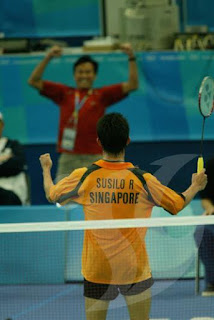 |
| Picture from Upswinghealth |
She saw 3 physiotherapists concurrently last year, but none really treated her. They all just gave her exercises to do.
After assessing her, I told her she may have an osteochondral injury (or articular cartilage injury) in her ankle. I also shared with her a recent article (Toyooka et al, 2023) on how successful athletes are, at returning to pivoting sports after articular cartilage surgeries.
The scoping review evaluated the following articular cartilage procedures: microfracture, osteochondral autograft transplanation (OAT, or mosaicplasty, harvested from one's own joint), osteochondral allograft (OCT, using a cadaveric graft) and autologous chondrocyte implantation (ACI, or autologous chondrocyte transplantation, ACT ). All of which have been written here previously.
16 studies fulfilled the ine inclusion criteria, of which 7 studies evaluated the microfracture technique alone. 44 to 83 percent managed to return to sport (RTS) after 6.2 to 10 months. 25-75 percent managed to return to their preinjury level. Average defect size was between 1.9-4.9 cm2.
87-100 percent of athletes managed to RTS after their OAT or mosaicplasty surgery after 11.8 weeks to 6.5 months.. 67-93 percent managed to get back to their preinjury levels. Mean defect size varied from 1.34 to 2.9 cm2 (this is smaller than most OAT procedures that I've read previously).
For ACI, 33-96 percent managed to RTS 10.2 months after their surgery. 26-67 percent managed to return to their preinjury levels. Mean defect size ranged from 2.1 to 6.4 cm2. These athletes had also previously undergone an average up to 2.7 other surgeries.
The rate of RTS with the microfracture technique was not higher compared to other techniques in this review. This technique is usually the first-line treatment for articular cartilage injuries since it is relatively low cost and technical ease. Patients usually RTS within 9 months. The main disadvantage is that there is no restoration of hyaline cartilage. Fibrocartilage is formed after the procedure which may not tolerate pivoting sports. It is also not suitable for those with larger defect injuries. Defect sizes larger than 2 cm2 may not have good postoperative oucomes.
 |
| Microfracture awls to puncture holes in the bone |
 |
| Harvesting the bone plugs in the knee |
ACI requires 2 surgeries to restore the damages done to the hyaline cartilage lining the joint, described in more detail in a previous post. For this review, 33-96 percent managed to RTS 10.2 months after their surgery. 26-67 percent managed to return to their preinjury levels in high demand pivoting athletes. Pivoting sports may have a lower RTS ate compared with other sports.
 |
| ACI |
Based on this review, the OAT procedure had the highest RTS rate in pivoting sports. They also returned to sport faster, especially when the defect size is small. For large defects, OCA and ACI may be considered with ACI preferred since OCA (caderveric) has many limitations like being expensive, limited in supply and restricted in many countries. Harvested bone plugs also need to be implanted within 14-21 days.
Most studies in this review reported high RTS rates although return to preinjury level was lower. RTS is a very critical variable and benchmark (to me) for patients who are athletes. These data can be used as a basis for selecting treatment options.
Not only there are very few studies that only study athletes, the sports they compete in also vary. There was a tendency for RTS to be higher when the level the athletes were competing in were higher (especially professional), perhaps due to their access and compliance with rehab protocols, adaptibility to competition and for financial reasons.
Note that there was not enough data on the lesion size to decide between ACI and OAT. There were no significant difference in short term results between the two, although ACI outperformed the OAT in 10 year outcomes (in 2 studies).
Well, to my receptionist and other athletes reading this post, I hope this helps with your decision making should you need to consider the different options to return to your sport. It is definitely a long and winding road, with treacherous falls along the way while attempting your comeback, but it can be done.
Trust me, I've had 3 knee surgeries, a skull fracture and broke my back twice. You just need to be be persistent and never give up. Our team in our clinics have been patients before too and know how it feels like to be a patient and will be able to understand and do their utmost to help you.
References
Bentley G, Biant LC, Vijayan S et al (2012). Minimum ten-year Results Of A Prospective Randomised Study Of Autologous Chondrocyte Implantation Versus Mosaicplasty For Symptomatic Articular Cartilage Lesions Of The Knee. JBJS Br. 94: 504-509.
Biant L, Vijayan S, Macmull S et al (2012). Autologous Chondrocyte Implantation Versus Mosaicplasty For Symptomatic Articular Cartilage Defects In The Young Adult Knee: Ten Year Results Of A Prospective Randomised Comparison Study. Orthop Proc. 94-B: 122-22
Toyooka S, Moatshe G, Persson A et al (2023). Return To Pivoting Sports After Cartilage Repair Surgery Of The Knee: A Scoping Review. Cartilage. Pub online. DOI: 10.1177/194760352211414







